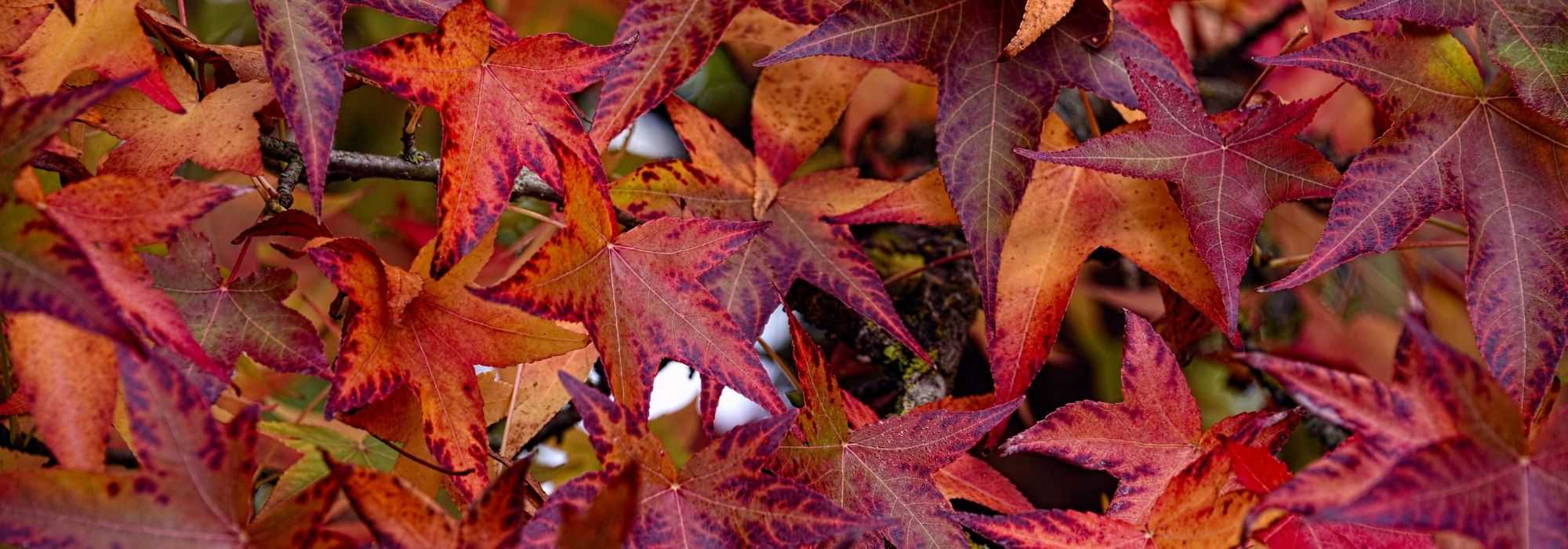
Liquidambar, American Sweetgum: planting, pruning, maintenance
Contents
Liquidambar in a nutshell
- Liquidambar is one of the most beautiful ornamental trees
- It is a unique tree in autumn due to the beauty of its colourful, incandescent foliage
- Easy to grow, it requires only fresh, non-calcareous soil and a prime location
- It is resistant to cold, diseases, and requires very little attention
- Majestic, it is ideal when planted alone in parks or large gardens, while the dwarf liquidambar will delight bush enthusiasts in smaller spaces!
A word from our expert
The Liquidambar is undoubtedly one of the most beautiful ornamental trees for the garden. It is often found in public spaces as a street tree, but this majestic species also deserves a prominent place in the garden where its graceful silhouette can showcase its splendour.
Its main asset lies in its deciduous foliage, which guarantees a spectacular display in autumn as it turns to gold, copper, and purplish-red, all warm and spicy hues that ignite the garden as the days shorten. Winter reveals its precious wood, a beautifully ridged bark that is undeniably charming, while spring and summer showcase its green foliage, sometimes splashed with yellow.
While the largest specimens, such as the Liquidambar styraciflua, commonly known as “American Sweetgum”, are capable of reaching 20 m in height, there are also species like Liquidambar orientalis or numerous cultivars of more modest dimensions that hardly exceed 10 m. If you love liquidambar but find it too large and space is limited in your garden, know that there is a dwarf liquidambar, the Liquidambar styraciflua ‘Gum Ball’, a variety that does not exceed 3 m in all directions, which will suit smaller gardens much better.
Hardy and easy to grow, the Liquidambar thrives in full sun and requires little attention once well established.
With its pyramidal habit, it forms a remarkable focal point when planted alone on a lawn, in a well-cleared spot, or in alignment along a long driveway.
Discover the liquidambar, this tree with dazzling autumn foliage that is suitable for both large and small gardens.
Description and Botany
Botanical data
- Latin name Liquidambar
- Family Hamamelidaceae
- Common name Liquidambar, American Sweetgum
- Flowering April-May
- Height 3 to 10 m and +
- Exposure Sun
- Soil type Clayey and cool
- Hardiness -20°C
The Liquidambar is a deciduous tree from the Hamamelidaceae family, like Hamamelis and Parrotia. The genus includes four species of trees native to temperate forests and the banks of large waterways in America, Turkey, and Asia.
The Liquidambar styraciflua, also known as “American Sweetgum”, is the most well-known species. It comes in numerous cultivars selected for their habit, more modest dimensions, and the shape and colour of their foliage, such as ‘Gum Ball’, a dwarf variety not exceeding 3 m, ‘Golden Sun’ with light yellow foliage in spring that turns green in summer, or ‘Aurea’ with green foliage speckled with yellow.
The Liquidambar orientalis, “Oriental Liquidambar” or “Styrax of the Levant”, native to Turkey, the Liquidambar acalycina or “Chinese Liquidambar”, both smaller than their American cousin, and the Liquidambar formosana from Taiwan, with equally beautifully coloured foliage in autumn, complete the genus.
In its natural habitat, the Sweetgum can reach up to 40 m in height, but in our regions, it will rarely exceed an average height of 20 m with a spread of 3 to 5 m. It has a slow growth rate in the early years, becoming quite rapid thereafter. It quickly forms a specimen of great stature. The new varieties offer more modest dimensions, rarely exceeding 10 m in height and 3-4 m wide after 10 years. It boasts a remarkable longevity of around 150 years.
Tall or columnar, conical or pyramidal, and more rarely rounded (‘Gum Ball’), the habit of Liquidambar varies significantly depending on the species and cultivars. However, it most often takes on a pyramidal silhouette that can be quite irregular, rounding with age.
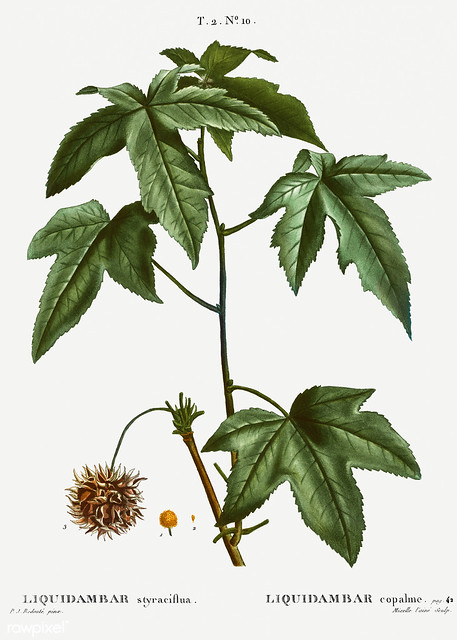
Liquidambar styraciflua – botanical illustration by P.J. Redouté
On a powerful taproot, this beautiful tree develops a very vertical trunk with dark grey corky bark that turns reddish-brown and fissures with age. The young shoots display ridges that accentuate into corky outgrowths as they mature. Its wood is valuable and resembles walnut so closely that Liquidambar is commonly referred to as “satin walnut.” Its bark exudes a cinnamon scent and releases a resin, styrax or sweetgum sometimes referred to as “Peru balsam,” which gave the tree its name liquidambar meaning “liquid” and “amber”, in reference to this balsamic and aromatic sap of amber colour that flows when its bark is incised.
Liquidambar is particularly valued for its elegant deciduous foliage that adorns the garden with sumptuous hues filling it with warm and spicy colours as the days shorten in autumn. The foliage consists of large palmate leaves, divided into 3 to 7 triangular or rounded lobes (Liquidambar styraciflua ‘Rotundiloba’), more or less notched that resemble maple leaves except that those of the sweetgum are arranged alternately on the shoots rather than oppositely. Measuring 10 to 18 cm wide, with finely serrated margins, they are pubescent, covered in reddish hairs on the underside of the lamina.
This ample palmate foliage releases a turpentine scent when crushed.
Like many trees in the Hamamelidaceae family, Liquidambar boasts beautifully coloured foliage in autumn. Ranging from light green to dark glossy green, sometimes bright green speckled and splashed with yellow or grey edged with cream from spring to summer, the leaves take on vibrant hues of gold, orange, yellow ochre, copper, crimson red to garnet, and violet-pink in autumn, varying in intensity depending on the cultivars and growing conditions.
The flowering of the Sweetgum is discreet. In spring, in April, small green-yellow apetalous unisexual flowers appear. The sweetgum is a monoecious species: male and female flowers coexist on the same tree. They take the form of erect catkins in spikes 5 to 7.5 cm long or spiny and pendulous clusters 1 to 3 cm in diameter depending on whether they are male or female.
Only after 25 years of cultivation do the spiky female flowers transform into fruits, brown spherical capsules measuring 2.5 to 3.4 cm that release small winged seeds reminiscent of maple samaras. They persist throughout winter, attached to the branches by a long peduncle.

Liquidambar styraciflua: green foliage then vibrant in autumn and its fruit
With excellent hardiness, the Liquidambar withstands the rigours of winter down to -15 to -20 °C, sometimes even beyond. It thrives in full sun and reveals its best colours in non-calcareous soil (slightly acidic), deep, heavy (clayey), rich, and cool. It is a versatile tree that can tolerate temporarily flooded soils and even accepts salt spray and pollution.
It can be planted either as a specimen on a large lawn in a spacious park or a garden of considerable size, near a pond or in alignment along a grand avenue or at the boundary of a property in a coastal garden.
The resin, styrax or sweetgum exuded by Liquidambar can be burned like incense and is highly valued for its dermatological properties, anti-stress effects and its ability to combat respiratory ailments. The Egyptians used it to embalm mummies, while the Native Americans chewed it as gum! In the 19th century, when Liquidambar was introduced to Europe, the resin of Sweetgum was used in the preparation of beauty creams and balms. This fragrant gum also serves as a perfume fixative and is widely used by perfumers.
Finally, the fragrant and valuable wood of Liquidambar was highly sought after in cabinetmaking.
Main species and varieties
Today, there are many cultivars of Liquidambar styraciflua, the most commonly grown species in gardens, selected for their habit, the colour of their leaves, and their more compact growth compared to the typical species. For example, the impressive size of this tree has been happily reimagined in the more compact form of the cultivar ‘Gum Ball’, which finally allows the liquidambar to fit into our smaller gardens.
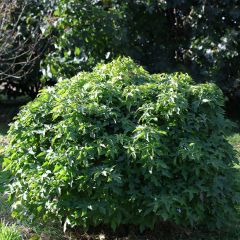
Liquidambar styraciflua Gum Ball - American Sweetgum
- Flowering time May
- Height at maturity 3 m
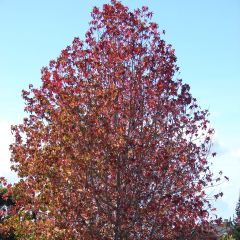
Liquidambar styraciflua - American Sweetgum
- Flowering time May
- Height at maturity 20 m
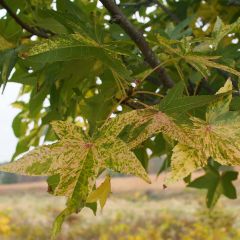
Liquidambar styraciflua Aurea - American Sweetgum
- Flowering time May
- Height at maturity 9 m
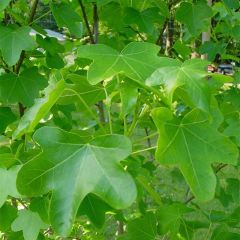
Liquidambar styraciflua Rotundiloba - American Sweetgum
- Flowering time May
- Height at maturity 18 m
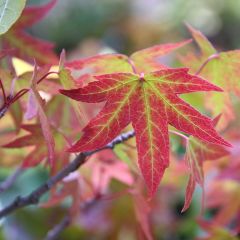
Liquidambar styraciflua Worplesdon - American Sweetgum
- Flowering time May
- Height at maturity 12 m
Discover other Liquidambar - Sweetgum
View all →Available in 1 sizes
Available in 2 sizes
Available in 1 sizes
Available in 2 sizes
Available in 1 sizes
Available in 2 sizes
Available in 1 sizes
Available in 1 sizes
Available in 1 sizes
Available in 1 sizes
Planting Liquidambar
Where to Plant?
The liquidambar has a good hardiness down to -15°-20°C, allowing it to be planted in all regions. However, in areas with long winters, provide it with a well-sheltered spot as late frosts could damage its aments. Native to wet areas and well-resistant to sea spray, it will thrive in the rainy climates of coastal regions.
It should receive maximum sunlight to produce beautiful autumn colours.
It will easily settle in full sun, which will enhance its sumptuous autumn hues. It prefers heavy, cool soils. It requires a clay or clay-loam soil, rich, deep, well-draining in winter, cool, and even moist, as it demands a certain level of moisture in the soil to flourish. Its root can tolerate temporary immersion but dislikes marshy lands!
It prefers rather acidic soil, definitely not calcareous. While it is sensitive to lime, this tree is resistant to urban pollution, making it a good candidate for city gardens.
As its taproot does not transplant well, think carefully about the location you choose for it before planting, as once well-rooted, it will grow about 40 to 50 cm per year. Give it ample space because at maturity, the tallest sweetgums will reach an average height of 20-22 m with a spread of 7 m.
To fully enjoy its remarkable autumn display and its wonderful elegant silhouette, reserve a well-cleared spot in the garden for this tree.
Its beautiful dimensions make it a magnificent specimen to plant in isolation on a large lawn in a vast park or large garden, or as a lining tree to majestically border a path or adorn a water feature where it can reflect.
In a garden where space is limited, to enrich a shrub thicket or a free-standing hedge, prefer a dwarf variety of American Sweetgum, such as Liquidambar styraciflua ‘Gum Ball’ which will not exceed 3 m in all directions.
When to Plant?
You should plant the liquidambar or sweetgum preferably in autumn, from September to November to encourage its rooting before winter. Container-grown specimens can also be planted in spring from February to April, avoiding periods of frost or extreme heat.
How to Plant?
In very calcareous soil, we recommend adding heather soil at planting. Once well established, do not move the Liquidambar as its root will not tolerate being transplanted well. Allow sufficient space at least 5 to 8 m from another tree, and between 3 and 5 m for cultivars with a more compact growth. You can also plant it in groups of 3 or 5 to create a truly majestic thicket.
To plant your sweetgum:
- Start by digging a wide hole at least three times the volume of the root ball
- Spread gravel at the bottom of the hole to aid drainage
- Add half garden soil mixed with heather soil if the ground is calcareous
- Incorporate well-rotted compost
- Plant the tree at collar level
- Stake if necessary
- Firm the soil and water regularly until it takes, as well as in the first few years
- Mulch to retain moisture at the base during hot periods
To ensure successful planting, consult our video on how to plant a tree.
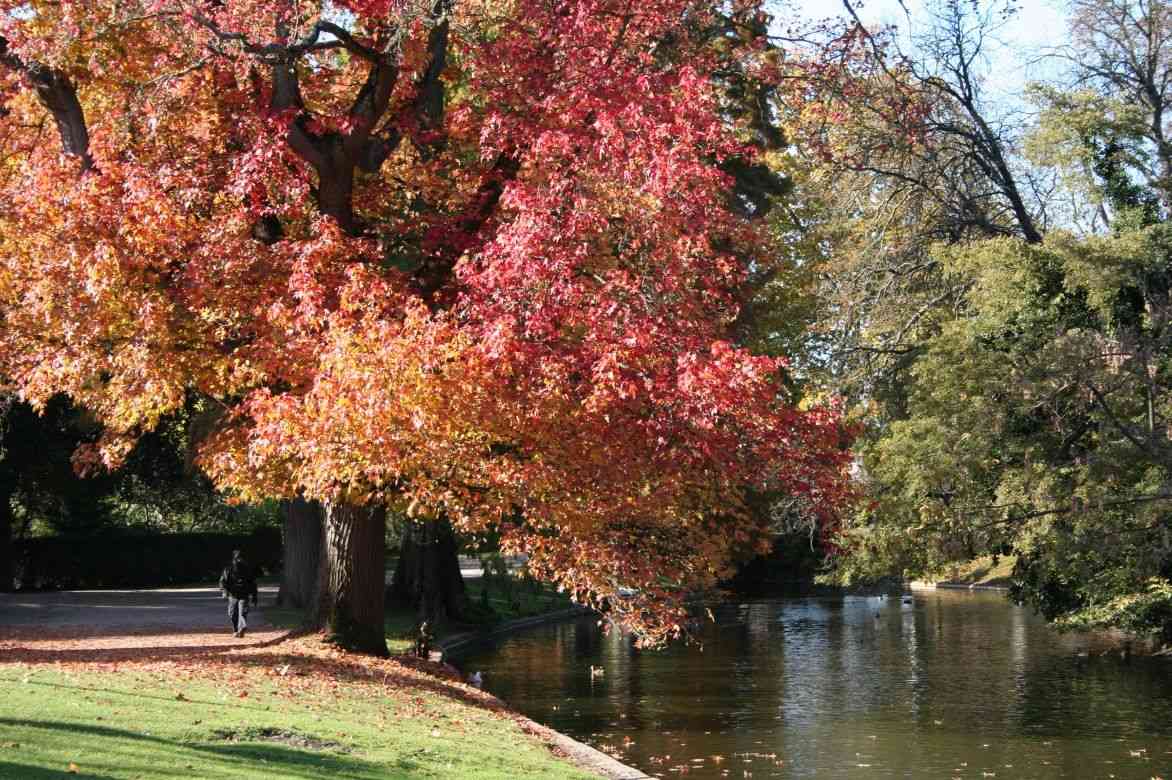
Maintenance and Pruning of Liquidambar
The Liquidambar requires very little maintenance and grows without special care.
During the first few years, it needs regular watering. In summer, monitor its water needs and water generously during dry spells. Once well established, it will be content with rainwater!
A good mulch in summer will help keep the soil cool and in winter protect young trees from severe frosts.
Every spring, amend the soil with a good organic fertiliser such as manure or compost.
Pruning is not necessary or recommended. In autumn or late winter, you can intervene only to remove dead, dry, or damaged wood. Between mid-August and the end of September, lightly prune misplaced or overcrowded branches.
When planted in good conditions, the Liquidambar proves resistant to diseases.
Multiplication
The Sweetgum can be propagated by sowing (a very long process, as it can take up to 2 years before germination), by division of suckers, by propagation by cuttings (somewhat hit-or-miss), and by layering.
By separating suckers
This is undoubtedly the simplest method of propagation. Some sweetgums tend to produce shoots around the parent plant. In autumn, separate the suckers with a spade, cutting the root as close to the main trunk as possible. Transplant these young plants immediately into fresh soil.
By layering
Layering the Liquidambar is straightforward and allows for the production of a new plant identical to the parent, although root development is very slow.
- In autumn, lay one of the lower branches at the base of the tree
- Remove the leaves from this part of the stem and incise the bark for a few centimetres
- Dig a furrow near the parent plant
- Lay the branch in the furrow and bury part of it to encourage rooting
- Cover the furrow and secure the layer with metal hooks
- Raise the end and stake the aerial part
- You can separate the layer from the parent plant and replant it in the ground when it has developed sufficient roots
Taking cuttings of sweetgum
- In autumn-winter, using pruning shears, take cuttings of mature wood, about 20 cm long
- Remove the leaves from the bottom of the stem
- Plant the cuttings in pots, in a mixture of sand, turf, and moist soil
- Keep the substrate moist until rooting occurs
- Rooting is slow and can take several years
- Once well-rooted, repot them individually in pots filled with compost and transplant in the following autumn
Associate the American Sweetgum
The American Sweetgum requires a large space; it is a species that thrives on its own and will stand out as a majestic punctuation in the middle of a lawn in a large garden. However, it is easy to pair with other plants that enjoy the same cool environments and deep soils. Resistant to both pollution and sea spray, its presence is essential in a large city garden as well as in coastal gardens where it can accentuate a pathway. With its colourful foliage, it is indispensable for creating stunning autumnal atmospheres.
To compose a symphony of spicy hues, place it alongside other trees and shrubs with coloured foliage such as Ginkgo Biloba, Acer or Japanese maples, Cornus, birches, and Hamamelis.
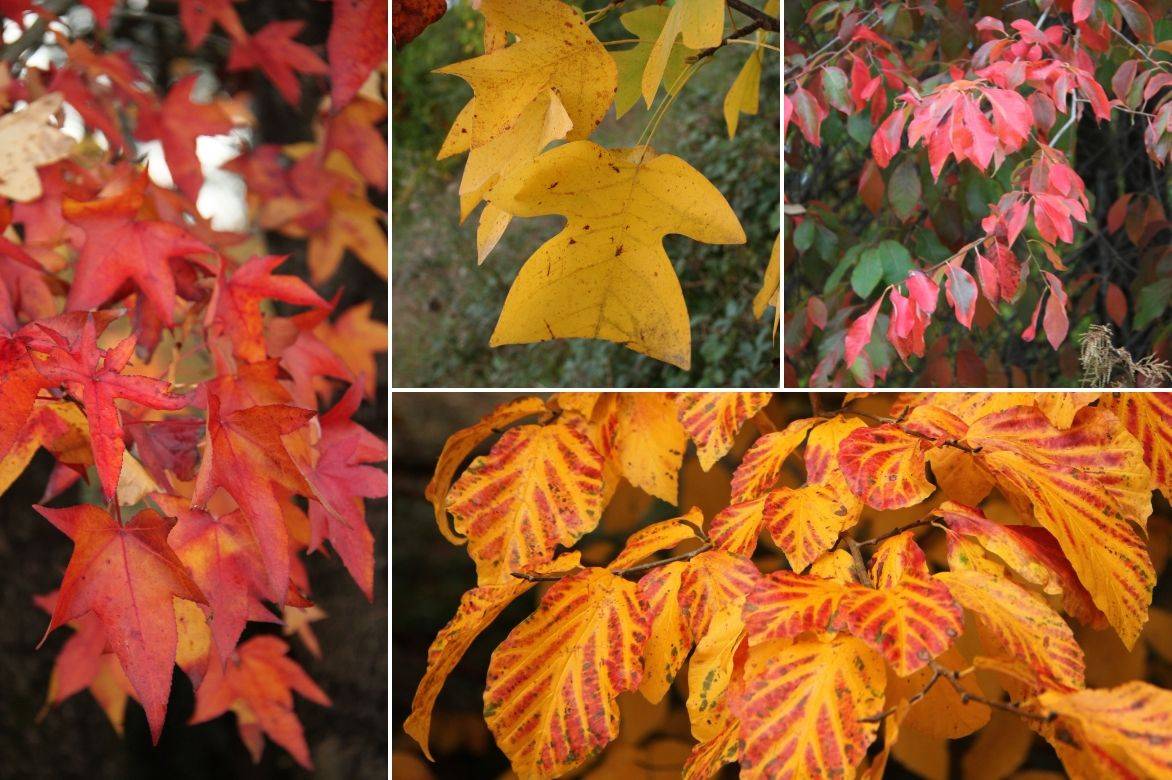
An example of an autumnal association in a grove: Liquidambar styraciflua, Liriodendron tulipifera, Nyssa sylvatica, and Parrotia persica
You will create a dazzling grove in autumn by pairing it with a Virginia Tulip Tree (Liriodendron tulipifera), Oxydendron arboreum, Parrotia persica, and Black Gum, which also don splendid autumn hues.
This tree, which prefers acidic soils, can serve as a backdrop for a mix of heather soil shrubs such as dwarf Rhododendrons, hydrangeas, and Chinese azaleas.
To fully enjoy its splendour, plant it against a backdrop of permanent greenery made up of conifers such as Pinus peuce or Macedonian Pine, Taxodium distichum or Bald Cypress, or Metasequoia glyptostroboides ‘Gold Rush’.
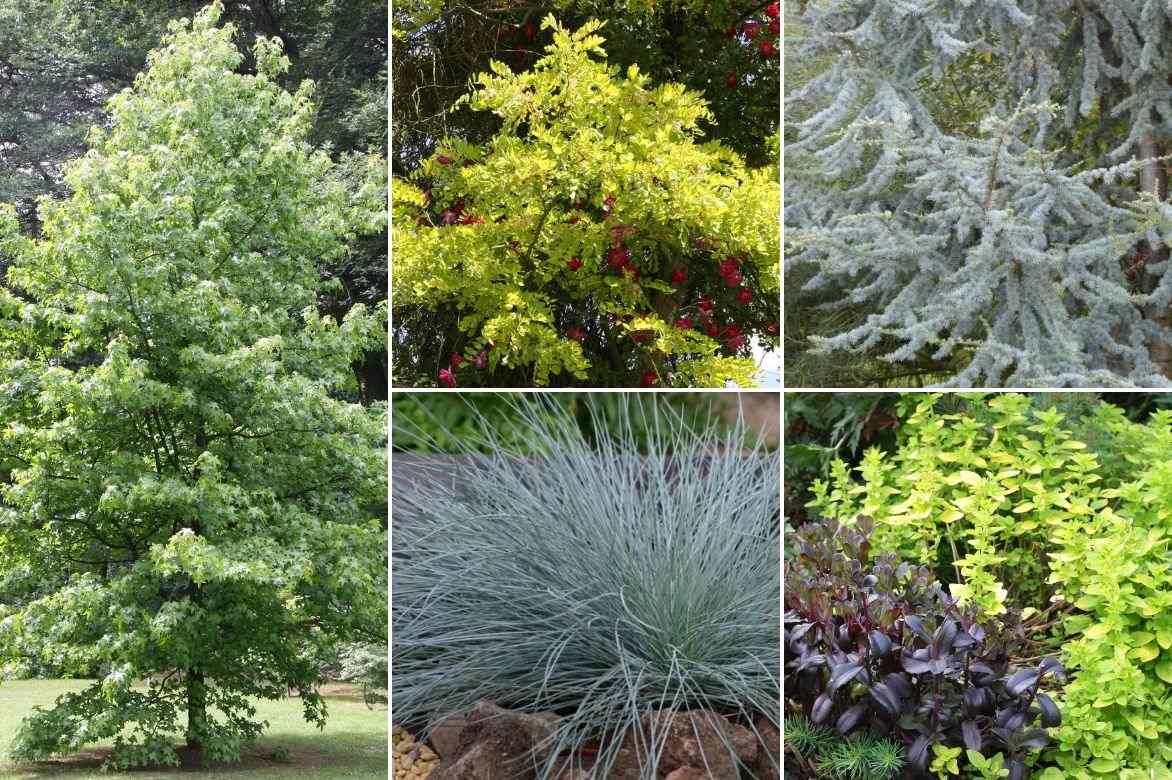
An idea for association: Liquidambar styraciflua (or the stunning variety ‘Worplesdon’), Robinia pseudoacacia ‘Frisia’ where you can train a rambling rose like ‘American Pillar’ or ‘Maria Lisa’, Cedrus libani ‘Atlantica ‘Glauca’, Festuca ‘Intense Blue’, Sedum ‘José Aubergine’, and Origanum vulgare ‘Aureum’
In spring and summer, accompany its bright green foliage with spring bulbs in acid green/white tones such as daffodils, Dutch Iris, anemones nemorosa, botanical tulips, and let a Clematis montana climb to complete this spring enchantment.
Cover its base with some evergreen groundcover perennials like creeping bugle or heucheras with sumptuous evergreen leaves of brick red or purple, lamb’s ear, a variegated ivy, hardy geraniums, or a sweet violet to keep its roots cool.
The smaller sweetgums will easily coexist with a purple hazel, a dwarf Japanese maple, a Ginkgo Biloba ‘Blagon’, or a Toona sinensis ‘Flamingo’ or Chinese Mahogany.
Useful resources
- If you wish to create a grove of trees and bushes with spectacular autumn foliage, discover our collection of autumn-coloured bushes
- Subscribe!
- Contents
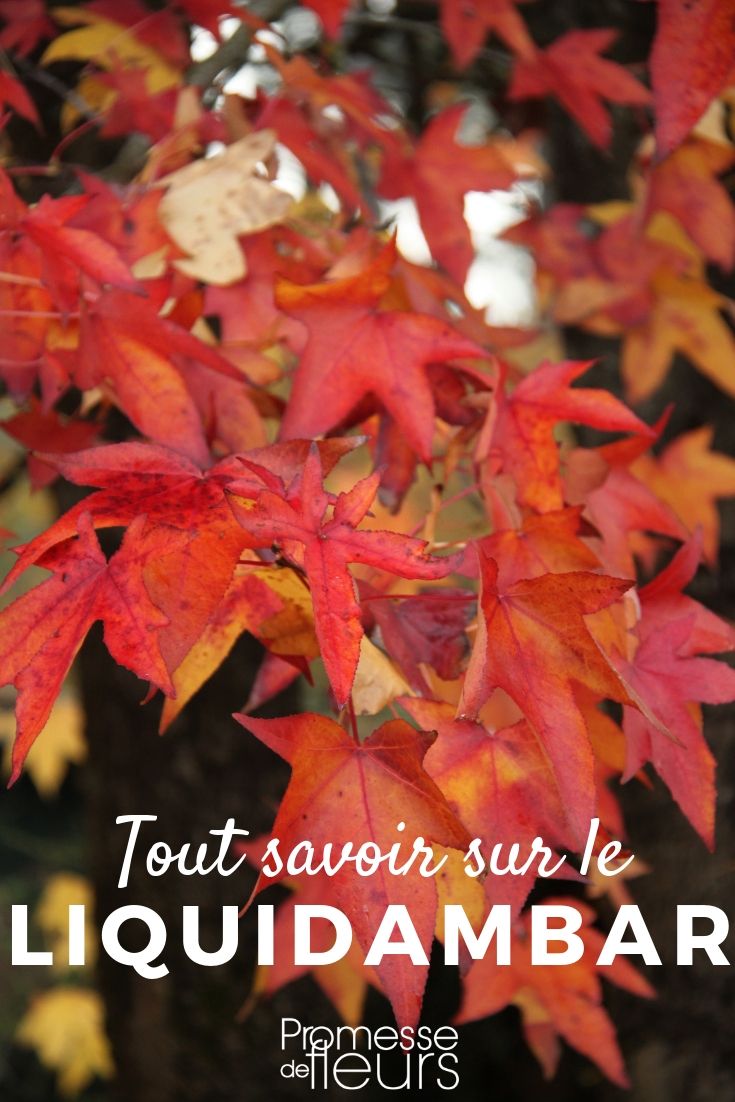































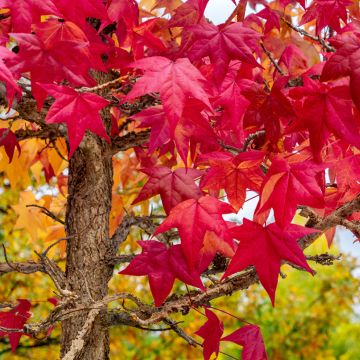

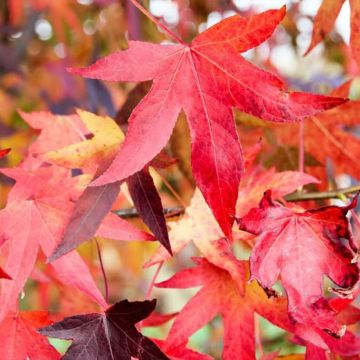

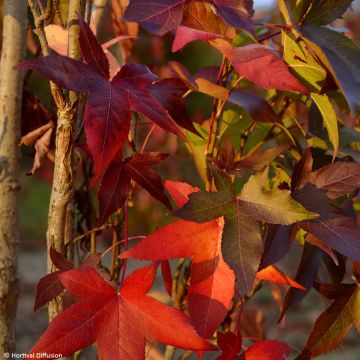

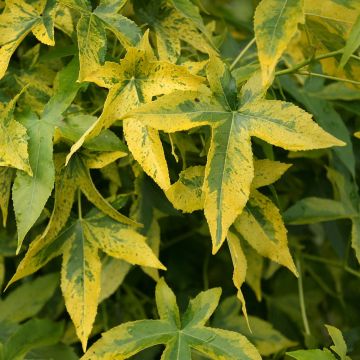
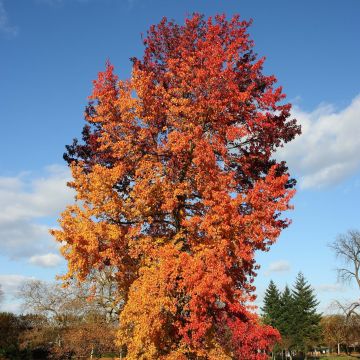
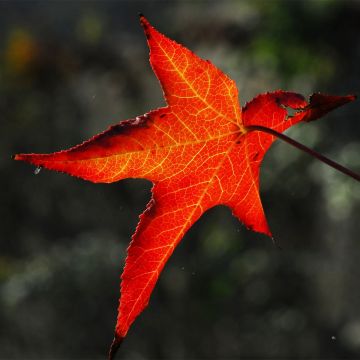
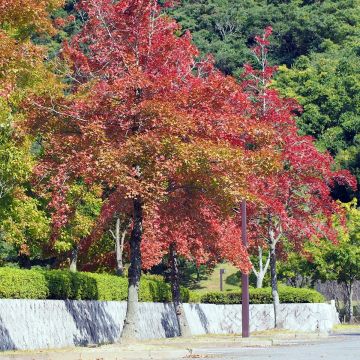
Comments